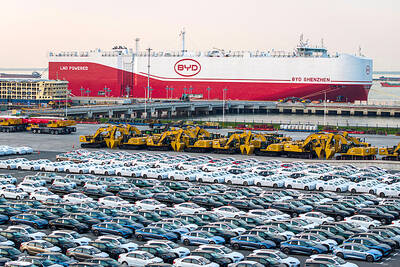HTC Corp (宏達電) yesterday reported revenue of NT$430 million (US$14.89 million) for last month, down 47 percent from NT$817 million in September and 34 percent from NT$656 million a year earlier.
Revenue in the first 10 months of the year plunged 47.7 percent to NT$4.64 billion from the same period last year.
HTC has been moving into virtual reality, forming a strategic partnership with Valve Corp in 2015 in hopes of reviving its fortunes.

Photo: Wang Yi-hung, Taipei Times
However, its VR efforts have yet to bear fruit and the company continues to rely heavily on mobile phones to drive its business.
The release of the HTC U20 5G in September gave the company its best month this year, with revenue soaring 88 percent to NT$817 million from August, but still declining 35.9 percent from a year earlier.
Priced at NT$18,990, it was relatively affordable compared with other 5G handsets.
On Oct. 20, HTC launched the 4G HTC Desire 20+, a mid-range model priced at NT$8,940.
This month, it made the U20 5G available in black.
Wistron Corp (緯創), an iPhone assembler, announced that revenue last month rose 4.5 percent sequentially to NT$92.1 billion, but declined 9.7 percent from a year earlier.
For the first 10 months, revenue slid 3.3 percent year-on-year to NT$684.7 billion.
Contract electronics manufacturer Inventec Corp (英業達) also saw revenue last month fall 18.9 percent month-on-month and 12.6 percent year-on-year to NT$42.1 billion.
The company said that it was hampered by supply shortages for its laptop and server products, leading to lower production.
However, revenue in the first 10 months edged up 1.3 percent from a year earlier to NT$424.9 billion, it said..

Micron Memory Taiwan Co (台灣美光), a subsidiary of US memorychip maker Micron Technology Inc, has been granted a NT$4.7 billion (US$149.5 million) subsidy under the Ministry of Economic Affairs A+ Corporate Innovation and R&D Enhancement program, the ministry said yesterday. The US memorychip maker’s program aims to back the development of high-performance and high-bandwidth memory chips with a total budget of NT$11.75 billion, the ministry said. Aside from the government funding, Micron is to inject the remaining investment of NT$7.06 billion as the company applied to participate the government’s Global Innovation Partnership Program to deepen technology cooperation, a ministry official told the

Taiwan Semiconductor Manufacturing Co (TSMC, 台積電), the world’s leading advanced chipmaker, officially began volume production of its 2-nanometer chips in the fourth quarter of this year, according to a recent update on the company’s Web site. The low-key announcement confirms that TSMC, the go-to chipmaker for artificial intelligence (AI) hardware providers Nvidia Corp and iPhone maker Apple Inc, met its original roadmap for the next-generation technology. Production is currently centered at Fab 22 in Kaohsiung, utilizing the company’s first-generation nanosheet transistor technology. The new architecture achieves “full-node strides in performance and power consumption,” TSMC said. The company described the 2nm process as

Shares in Taiwan closed at a new high yesterday, the first trading day of the new year, as contract chipmaker Taiwan Semiconductor Manufacturing Co (TSMC, 台積電) continued to break records amid an artificial intelligence (AI) boom, dealers said. The TAIEX closed up 386.21 points, or 1.33 percent, at 29,349.81, with turnover totaling NT$648.844 billion (US$20.65 billion). “Judging from a stronger Taiwan dollar against the US dollar, I think foreign institutional investors returned from the holidays and brought funds into the local market,” Concord Securities Co (康和證券) analyst Kerry Huang (黃志祺) said. “Foreign investors just rebuilt their positions with TSMC as their top target,

POTENTIAL demand: Tesla’s chance of reclaiming its leadership in EVs seems uncertain, but breakthrough in full self-driving could help boost sales, an analyst said Chinese auto giant BYD Co (比亞迪) is poised to surpass Tesla Inc as the world’s biggest electric vehicle (EV) company in annual sales. The two groups are expected to soon publish their final figures for this year, and based on sales data so far this year, there is almost no chance the US company led by CEO Elon Musk would retain its leadership position. As of the end of last month, BYD, which also produces hybrid vehicles, had sold 2.07 million EVs. Tesla, for its part, had sold 1.22 million by the end of September. Tesla’s September figures included a one-time boost in